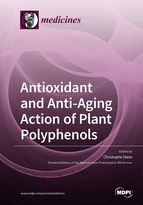Antioxidant and Anti-Aging Action of Plant Polyphenols
A special issue of Medicines (ISSN 2305-6320).
Deadline for manuscript submissions: closed (31 December 2018) | Viewed by 85179
Special Issue Editor
Interests: chemistry of natural products; analytical methods; HPLC; LC-MS; polyphenols (lignans, flavonoids, phenolic acids); ethnopharmacology; history of pharmacy
Special Issues, Collections and Topics in MDPI journals
Special Issue Information
Dear Colleagues,
Polyphenols are plant natural products found in fruits, vegetables and seeds that we consume daily. They have a wide range of applications as food supplements or medicines. The growing antioxidant and anti-aging (Sensu largo) potential of polyphenols in the field of public health (to fight against degenerative diseases such as cancer, cardiovascular diseases, type II diabetes, hypertension or Alzheimer's disease) will be considered in this Special Issue.
But we will also consider the other side. While most in vitro and in cellulo assays are not disputed, it is sometimes more difficult to evaluate these beneficial effects at the level of the whole organism. Many epidemiological or clinical studies are in this respect at odds with some of these assays. Some other questions about their active concentrations, possible “cocktail effects”, for examples, also remain little (and sometimes not) discussed in the science of nutrition or in disease prevention policies. This Special Issue will also examine critical review, opinion papers or controversial views on this topic.
Dr. Christophe Hano
Guest Editor
Manuscript Submission Information
Manuscripts should be submitted online at www.mdpi.com by registering and logging in to this website. Once you are registered, click here to go to the submission form. Manuscripts can be submitted until the deadline. All submissions that pass pre-check are peer-reviewed. Accepted papers will be published continuously in the journal (as soon as accepted) and will be listed together on the special issue website. Research articles, review articles as well as short communications are invited. For planned papers, a title and short abstract (about 100 words) can be sent to the Editorial Office for announcement on this website.
Submitted manuscripts should not have been published previously, nor be under consideration for publication elsewhere (except conference proceedings papers). All manuscripts are thoroughly refereed through a single-blind peer-review process. A guide for authors and other relevant information for submission of manuscripts is available on the Instructions for Authors page. Medicines is an international peer-reviewed open access monthly journal published by MDPI.
Please visit the Instructions for Authors page before submitting a manuscript. The Article Processing Charge (APC) for publication in this open access journal is 1400 CHF (Swiss Francs). Submitted papers should be well formatted and use good English. Authors may use MDPI's English editing service prior to publication or during author revisions.
Keywords
- anti-aging
- antioxidant
- polyphenols
- degenerative diseases
- in vitro assays
- in cellulo assays
- epidemiological studies
- clinical trials





